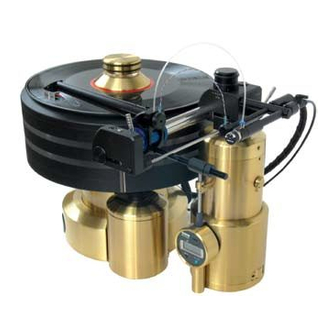Summary of Contents for Kuzma AIR LINE
- Page 1 THEORY BEHIND»AIR LINE« TANGENTIAL AIR BEARING TONEARM KUZMA AIR LINE AIR BEARING TONEARM 1. Basic Theory 2. Principles of air bearing 3. Practical solutions to problems of air bearings 4. Description of the »Air Line« air bearing tonearm...
-
Page 2: Basic Theory
1. BASIC THEORY In principle, we all agree that a cartridge should follow the same line when playing an LP as the cutter head was travelling when cutting grooves on the master disc. This is tangential on any groove, in a straight line from the outer edge of an LP towards the centre of the record. - Page 3 In both types of tonearm the choice of headshell, tube shape and material have similar effects. The main structure can also be optimally designed in both cases. So what really are the main differences which affect reproduction, can they be heard and what makes some of the best tangential tonearms sound so different and so much better than the best pivoted arms? Certainly if only perfect tracking geometry mattered, things would be very simple.
- Page 4 2. PRINCIPLES OF AIR BEARINGS Let us first look at the main principle of the simplest air bearing. This is a flat bearing for moving loads on a flat surface. (Fig A ) Fig. A: Flat bearing Imagine a flat surface. On top of this surface we have a block of metal. If we provide air flow between the flat surface and the bottom of the block, then the block will rise above the flat surface.
- Page 5 Imagine what will happen if you press the floating block down in the middle. The gap will be reduced and restored after release of pressure. Thus the block will move up and down. This system is unstable and sensitive to outside forces. Movement is possible in all directions along the flat surface.
- Page 6 If we bring pressurised air between the sleeve and the rod the compressed air will « lift the block«. Because the sleeve is surrounding the rod, however, forces are equal on all sides and we have a sleeve floating around the rod without touching any surface.
- Page 7 moving the cartridge in the grooves. Of course this also happens in pivoted arms, but due to differences in construction ie. loose bearings, vibration of bearings and other parts. To practically avoid this effect we must use a stiff bearing, which automatically reacts to these external forces.
- Page 8 the tube when a proper airbearing is used in the construction of the tonearm. In pivoted tonearms, due to construction of an offset angle of the headshell, forces are pulling the cartridge along the tube and pushing the cartridge towards the inner groove.
- Page 9 mandatory. This means, among other things, that there must be only a small gap between the shaft and the bearing and as many small holes as possible as air outlets. Since we are talking about a few thousandths of a mm we must supply clean air at high pressure.
- Page 10 6 months. In the summer, or in areas with higher humidity the bottle may need emptying more often. 4. DESCRIPTION OF THE » AIR LINE « AIR BEARING TONEARM The tonearm base has a VTA adjustment which holds the stainless steel shaft of the main bearing.
- Page 11 The main tube is machined from three solid blocks of aluminium and made into a stiff hollow conical tube. Azimuth adjustment is controlled by a zero play, non-resonant locking mechanism, which allows for fine repeatable adjustments. The solid aluminium headshell is shaped to minimise resonance and further damped by the use of four ribs.
- Page 12 The system of air supply seems to be complicated at first but is actually simple to use and certainly worth the effort in view of the improvement in sound quality obtained. Franc Kuzma...















Need help?
Do you have a question about the AIR LINE and is the answer not in the manual?
Questions and answers